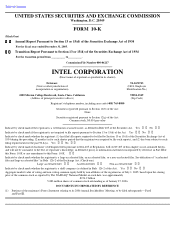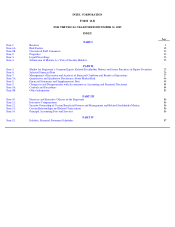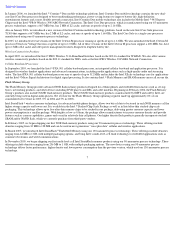Intel 2005 Annual Report Download - page 8
Download and view the complete annual report
Please find page 8 of the 2005 Intel annual report below. You can navigate through the pages in the report by either clicking on the pages listed below, or by using the keyword search tool below to find specific information within the annual report.
Table of Contents
Digital Enterprise Group
The Digital Enterprise Group (DEG) designs and delivers computing and communications platforms for businesses and service providers. DEG
products are incorporated into desktop computers, the infrastructure for the Internet and enterprise computing servers. DEG’s products include
microprocessors and related chipsets and motherboards designed for the desktop (including consumer desktop) and enterprise computing market
segments, communications infrastructure components such as network processors and embedded microprocessors, wired connectivity devices, and
products for network and server storage.
Net revenue for the DEG operating segment made up approximately 65% of our consolidated net revenue in 2005 (72% in 2004 and 77% in 2003).
Revenue from sales of microprocessors within the DEG operating segment represented approximately 50% of consolidated net revenue in 2005 (57%
in 2004 and 60% in 2003).
Desktop Market Segment
We develop platform solutions based on our microprocessors, chipsets and motherboard products, which are optimized for use in the desktop market
segment. Our strategy is to introduce platforms with improved performance per watt, tailored to the needs of different market segments using a tiered
branding approach. Our tiered branding approach focuses on both the performance market segment, which includes the Pentium
®
4 processor and the
Pentium D processor, and the value market segment, which includes the Celeron processor and the Celeron
®
D processor. In addition, current versions
of the Intel Core Duo processor that were originally designed for mobile form factors are available for small desktop form factors. Form factor refers
to the physical size and shape of an end product.
In 2005, we launched the Intel Pentium 4 processors 630, 640, 650, 660 and 670 supporting HT Technology, running at speeds ranging from 3.0 to
3.8 GHz. Each of these processors supports 64-bit memory addressability through Intel EM64T, has 2 MB of L2 cache and supports an
800-MHz system bus. We also introduced the Intel
®
Professional Business Platform based on these processors, the Intel
®
945G Express Chipset and
an optional Intel
®
PRO/1000 PM Network Connection. The Intel Professional Business Platform is designed to bring advanced security, management
and collaboration technologies to mainstream business PCs and includes Intel AMT.
In May 2005, we introduced a desktop PC platform based on dual-core Pentium D processors 820, 830 and 840, and the Intel
®
945P Express Chipset.
These Pentium D processors feature speeds ranging from 2.80 to 3.20 GHz, 2 MB of L2 cache (1 MB for each processor core), support for an
800-MHz bus and 64-bit memory addressability through Intel EM64T. This platform supports multitasking for multimedia and digital content, along
with support for consumer electronics features such as surround-sound audio, high-definition video and enhanced graphics capabilities.
In June 2005, we introduced several Celeron D processors that support 64-bit memory addressability through Intel EM64T, enabling 64-bit computing
capability for the value PC segment. The Celeron D processors 326, 331, 336, 341, 346 and 351 run at speeds ranging from 2.53 to 3.06 GHz, feature
256 KB of L2 cache and support a 533-MHz bus. At the same time, we also launched the Celeron D processor 350, which runs at speeds of up to
3.20 GHz, supports a 533-MHz bus and includes 256 KB of L2 cache, but does not support 64-bit memory addressability.
In November 2005, we announced desktop processors with hardware-enabled support for Intel Virtualization Technology. The Intel Pentium 4
processors 662 and 672 supporting HT Technology run at speeds of up to 3.80 GHz. Both support an 800-MHz
bus, and feature 2 MB of L2 cache and
support 64-bit memory addressability through Intel EM64T.
In January 2006, we introduced the first desktop processors manufactured using our 65-nanometer process technology. The Intel Pentium 4 processors
631, 641, 651 and 661 supporting HT Technology run at speeds ranging from 3.00 to 3.60 GHz, feature 2MB of L2 cache and support an
800-MHz bus and 64-bit memory addressability through Intel EM64T.
Also in January 2006, we introduced the Intel Core Duo processor, a dual-core processor manufactured using our 65-nanometer process technology.
The Intel Core Duo processor supports a 667-MHz bus, has 2 MB of L2 cache and runs at speeds of up to 2.16 GHz.
4





















